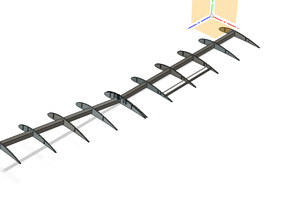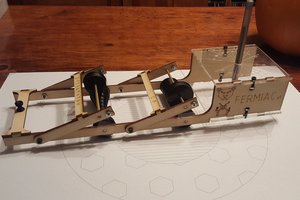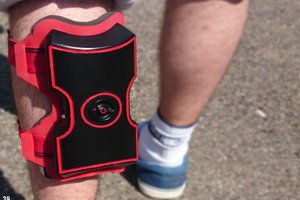The Candy-Pult was a last minute follow-on project to the "Candy Cannon" project which sadly didn't make it through the engineering phase due to a lack of accuracy a tendency to pulverize the candy.
Here is a youtube video of the Candy-Pult in action:
The catapult used by the candy-pult was and upscaled version of the Young Engineers: Pyramid Catapult which was a clever design that used three stick triangle to form a pyramid and rubber bands. My version used 3/4" x 3/4" x 2' sticks instead of popsicle sticks. The triangles were glued and screwed together, then connected together with cable ties to form the pyramid. The launching arm was a lightweight metal garden pole. I tried using bungie cords instead of rubber bands, but it had a lot of aiming and distance issues. I finally ended up just cable tying the launch arm to the pyramid and the flex of the launch arm provide plenty of spring to accurately send the candy to the web target.

The web target used a loop made from a piece of pex tubing. The material was salvaged from a broken umbrella, then I stretched white string across to build the web.

The candy collector and slide were just made of cardboard. Because of the limited time, the Candy-Pult was hobbled together quickly with no time for fun electronics or cnc parts. But sometimes the simplest solutions work the best.

The failed Candy Cannon was a much more interesting project. It used a piece of 2" PVC tubing connected to shop vac to launch the candy. It had 3D printed chamber for loading the candy. It's main failing was that it was unable handle the different sizes of candy. Snicker bars usually launched fairly well. Twix bars were too skinny and didn't offer enough wind resistance to get much velocity. The snack size packages of M&M fit a bit too well and would leave the PVC tube with too much energy. If the package didn't split open, the M&Ms inside would get pretty shattered.
One final note, the Pumpkin band members had the most technology, but there wasn't time to document it. They had animatronic eyes with WS2812 addressable LEDs inside. The animatronics were controlled with Nordic Semiconductor NRF52832 bluetooth processors and were all connected using a bluetooth mesh so they could operate in sync. In addition, the cyclops pumpkin eye and had a "Person Sensor" so it had the ability to identify faces and track them as they moved.



 Jeremy Ruhland
Jeremy Ruhland
 TAIBHSE DESIGNS
TAIBHSE DESIGNS